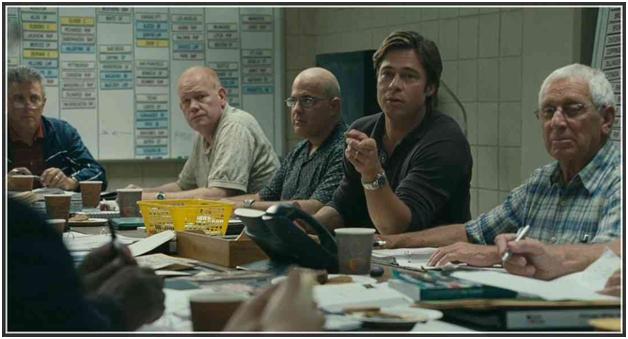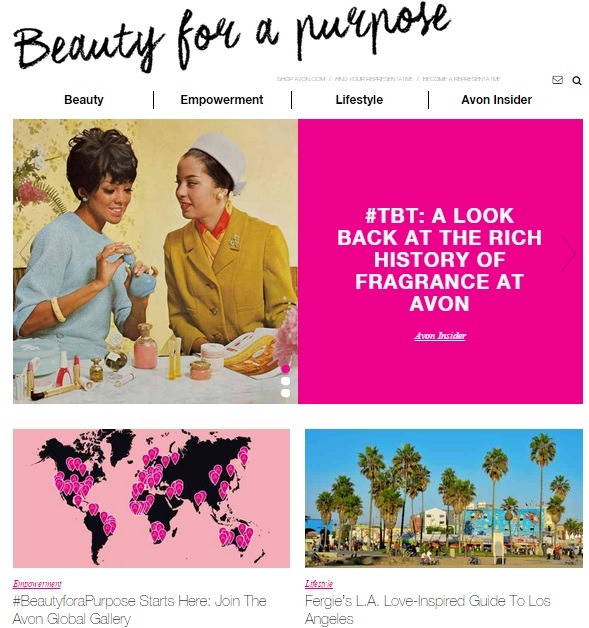If you saw the movie Moneyball starring Brad Pitt as Oakland A’s General Manager Billy Beane, you probably remember those classic scenes about how an old-line brand struggles with changing its entire way of doing business. Beane had to morph the way the A’s approached scouting, player evaluation, and the game itself due to small budgets and changing times.
To accomplish this, he brought in a Harvard geek, Paul DePodesta, and started thinking more about algorithms than sacrifice bunts. It wasn’t easy changing the culture of an entrenched operation, especially with his group of grizzled scouts. These guys were bound and determined to judge talent the old-fashioned way – by observing, comparing notes, and using their decades of experience. Beane’s mission was to get them to embrace thinking differently, using a modes known as sabermetrics as the foundation. As you can see by the faces of these scouts, the transition wasn’t an easy one.
So when I read a recent story in Digiday’s “ThinkTank” by Shareen Pathak about how Avon is making the digital turn, it reminded me that legacy industries have the ability to adjust, adapt, and thrive. It’s just never easy.
The money quote is from Avon’s VP/Marketing, Matt Harker:
“I think digital is the secret weapon for Avon.”
For someone in a leadership position from a very old school company, this is an amazing strategic statement. Avon has created a campaign, “Beauty for a Purpose,” and it is content marketing on display, featuring an updated brochure, social media, as well as earned and paid advertising.
While you may think of Avon as salesladies going door-to-door, the new digitally-charged company features an online sales engine. But the real story behind the new campaign harkens back to Avon’s roots – 6 million reps worldwide evangelizing about women and their brand. Harker has the nomenclature down – he refers to his Avon ladies as “basic storytellers.”
But it begins and ends with training those famous Avon sellers about how to compete on the digital battlefield. They are being schooled about how to use content marketing to their advantage. This includes posting stories, videos, and pictures on social pages.
Another key factor for Avon is recommendation, something we talk about a lot within our Techsurveys and the power of the Net Promoter Score. As Harker points out, Avon is being driven by personal recommendations, and that’s how the brand plans to “reframe what the business model is about.”
For radio, this story is encouraging. Many have written Avon off as one of the next companies destined to fail. And yet, they are embracing digital, social, and content marketing – all the new tools of the trade. They have also committed to training, something that some of radio’s best companies are beginning to brace, too. The Entercom team headed up by Kim Reis is a good example of company-wide training, and there are other broadcasters taking a similar approach to helping airstaffs and programmers grow.
In the long run, this approach gives Avon the chance to leverage its legacy status over modern competitors like Birchbox and Sephora. In radio parlance, think of it as broadcasting retraining its workforce to be competitive against pure-plays and satellite radio. And in that context, Harker says timeless brands have an edge:
“I’d rather start with a brand that has a heritage. Because I don’t have to tell you why it has to mean something to you. That gives it a great foundation to start from. We count ourselves fortunate to have that. What I need to do is refresh the presentation and creativity around it, and maybe even the vernacular. But I can’t lose sight of the heritage.”
That sounds an awful lot like a great story for radio.
And we don’t even have to go door-to-door to tell it.
- What To Do If Your Radio Station Goes Through A Midlife Crisis - April 25, 2025
- A 2020 Lesson?It Could All Be Gone In A Flash - April 24, 2025
- How AI Can Give Radio Personalities More…PERSONALITY - April 23, 2025






If I may play the devil’s advocate:
Does the new technology work?
The As have not won a World Series since … when? But just across the bay …
And maybe Avon should double down and build on its flesh-and-blood strength of person-to-person marketing instead of going the digital route?
Questions are easy. Answers are hard. Time will tell if these high-tech approaches actually, you know, work.
BTW odds-makers are saying that the Giants have a much better chance of winning another title than does Oakland
Thanks, Dimitri, for the pushback. Regarding the A’s, victories are measured in different ways. Given their payroll and other impediments, you might consider their progress using sabermetrics a win, or at the very least, impressive. The fact they have redefined the standards of scouting and player evaluation for many teams also speaks to the validity of the approach. But there’s no arguing with the Giants’ accomplishments either.
As for Avon, I got the sense from the piece that their digital efforts are an adjunct to their heritage model – not a replacement. Like WalMart, BestBuy, and other traditional retailers, providing a competitive web component is impressive.
Radio needs all the personal, human, “door-to-door” contact it can muster. As yesterday’s post – “Science vs. Art” – pointed out, the human touch is key for broadcasting. But achieving a viable web and digital presence is critically important as consumers move from “regular radios” at home, work, and in cars to mobile devices and computers. Radio needs to turn that corner and provide seamless access and a great customer experience.
Yes?
Imagine if Avon was still selling the same product it did 30 years ago! There aren’t a ;ot of VCRs or Polaroid cameras for sale on Amazon.
Radio’s biggest challenge in staying relevant isn’t so much digital as content. If radio is becoming irrelevant to some, Frequency Modulation isn’t the reason, its almost total lack of change other than cost cutting – for 30 years.
Somebody…anybody, try something different. On a translator maybe – just try a format aimed at 12-30 year olds and see if they listen. Speaking of 30 year old references…”hello…McFly!”
No question about it, Bob. New formats, podcasts, video – they’re all part of the new content and distribution mix that radio would be wise to pursue.
Great analogies and content as always Fred, thank you.
Too often I think these arguments are presented as black and white, either you put all of your eggs in the digital basket and throw out “traditional” radio or you keep doing it the way you’ve been doing it and put little stock in digital. Like everything in life it just isn’t that simple. As is illustrated by Mr. Harker’s comments there are still useful pieces of what Avon has been doing since the company’s inception but they have to be incorporated into today’s marketplace. Billy Beane completely throwing out old school scouting is great for a movie script but in reality I’m willing to bet there was a marriage between the old and new to create a successful process for the A’s. The same model is the way forward for radio – a combination of what has always made radio a dominant medium along with integration into the latest ways to share and be heard.
Sean, it is a balance, especially for legacy brands like Avon or Z100. I love the enthusiasm of Harker and the idea off jumping into the digital pool with both feet. Thanks for taking the time to add some perspective.